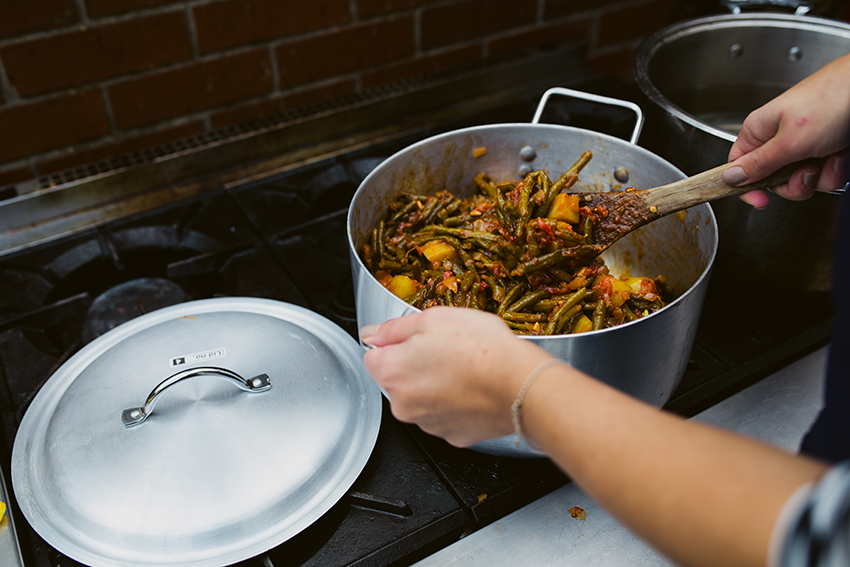Credit: Lisa Jane Photography
When you think of Greek food, what comes to mind? Is it souvlaki, or perhaps moussaka? Although you can get excellent grilled meats in Greece, this isn't everyday eating for most people. Vegetarian and even vegan food is regularly eaten, but isn't labelled as such. Rather it is just something delicious to eat. The history of poverty in the country, plus the influence of religious holidays and fasting, means vegetable based dishes using olive oil ('lathera' dishes, 'lathi' being the word for oil) is prevalent. My Greek Orthodox yaya still fasts to this day, and mostly eats a diet of olive oil and fresh vegetables.
Balance between body and soul...
What is the relationship between food and our bodies? For Greek people, eating is both nourishing for the body and the mind. In Ancient Greece they believed in the the balance between 'soma' (body), 'psyche' (spirit, or soul) and 'pneuma' (literally meaning breath, and related to your physiological spirit). Earlier this month we teamed up with yoga teacher Sophia Pym (a fellow half-Greek!) to explore that relationship, and give people an opportunity to feed your body and soul – bringing together the ethos of eating simple, vegetarian food while also engaging with your body.
The yoga lunch was held at Greenhouse on Green Lanes, and started with a flow and restore yoga class, balancing movement and rest for the guests.
Following the class came the lunch. The idea behind the menu wasn't deprivation, or providing low calorie food, but excellent produce and tasty, simple food. We put the menu together and realised that it was unintentionally vegetarian – proving how much variation there is in Greek cuisine.
Credit: Lisa Jane Photography
Simplicity and mountain tea...
One thing we really wanted to serve our yogis was some Greek mountain tea as it has a unique taste and some great health properties.
Greek mountain tea, or shepherd's tea, comes from the Sideritis plant and has an earthy herbal taste. It's full of antioxidents and is said to have a range of health benefits, from easing digestive problems to helping inflammation issues. My yaya would give it to me for any illness, especially colds, and it is particularly good in the morning with a little thyme honey (luckily raw honey is easy to get in Greece!). It is possible to find in the UK and if you do come across it, make sure you boil it down with the stem, leaves and flowers. My grandparents lived on the foothills of a small mountain range so we always had this in the house.
The great thing about Greek food is that it's meant for lunch. Things are rapidly changing in the country, especially in the cities, but in my yaya's sleepy village you still have a large lunch at around 2pm and then a siesta. At the weekends, the siesta is followed by dressing up in smart clothes and walking around the square for a 'volta' to catch up on the village gossip (while also parading around in your best outfits) as the sun goes down.
For this menu, we kept the idea of sharing plates to present a range of flavours and textures. Although Greek cuisine uses a small repertoire of ingredients, the way they're cooked opens up a huge language available to the cook.
Credit: Lisa Jane Photography
Pita and dips...
Instead of our usual koulouri, we decided to go with traganisti araviki pita, or pita crisps. We handmade the pitas and then roasted them with olive oil and lemon thyme to make the prefect receptacle for dips. Greeks love dips, and we made my godmother's ('nona') tztaztiki, and a smokey aubergine dip ('melintzanosalata'), very similar to baba ganoush. I love melintzanosalata because it has such few ingredients – aubergine, garlic, parsley, olive oil, lemon and salt – and yet has such a complex flavour profile.
To accompany the dips and pita we served two large salads – our tomato, red wine vinegar, greek basil and Cretan barley rusk salad; and our raw carrot and cabbage salad, lightly pickled in vinegar and salt.
Credit: Lisa Jane Photography
And then we thought, what goes well with salad? Fried cheese of course! This is a classic on a greek table, and you can use a few different types of cheese for it, as long as it's fairly hard and melts well. We went with kefalotyri (literally translating as 'head cheese'), which is made from sheep's milk and has great salty and sour taste while melting really well. This dish is part of the 'saganaki' type, which is named after the small frying pan it's cooked in. Other saganaki dishes include one with prawns, tomato and feta, or mussels and tomatoes. Our fried cheese saganaki is best served with a drizzle of thyme honey and a sprinkle of black sesame seeds.
Credit: Lisa Jane Photography
Spinach and green beans (with lots of feta of course)
For the main event, we wanted to offer a 'lathera' dish, and a classic that is well known to people in the UK. So we went with fasolakia and spanakopita.
Fasolakia is the kind of dish people will eat in the lent period before Easter, and has incredibly simple ingredients based around tomato, green beans and good olive oil. It's perfect served at room temperature with some crumbled feta and a hunk of bread.
Credit: Lisa Jane Photography
I'm sure you all know spanakopita, and although it's a simple spinach pie it can be tricky to make because of the delicate flavours involved. We decided to add feta (so actually a 'spanakopityropita' – not the easiest thing to say with a mouthful of pie), and then stuck to my great aunt Sophia's recipe which includes dill, spring onions and parsley. It was really easy for us to make a vegan option without feta.
Credit: Lisa Jane Photography
Apricot and pistachios...
After so much food we wanted to keep the dessert light. We didn't go with a traditional greek dish but rather something that uses classic Greek flavours but in a modern way. We found some excellent Greek yoghurt from my family hometown of Serres, so we served this with our apricot glyko koutalio which translates as apricot spoon sweet, preserved in syrup. This was topped with chopped pistaschio nuts and the option to drizzle some thyme honey, also from the Serres region.
Credit: Lisa Jane Photography
Greek coffee, Turkish coffee, Israeli coffee...
We finished the lunch in our usual way, with a small cup of bitter, chocolatey Greek coffee. Greek coffee is the same kind of coffee drunk across Greece, Turkey and the Middle East. It's boiled gently in a 'briki' pot, and although it looks like an espresso it's not meant to be drunk quickly while standing up but instead sipped over time and conversation. It comes either plain or with a little sugar, and is always drunk black. Honestly, the smell of Greek coffee might be one of the best smells there is...
Credit: Lisa Jane Photography
Thanks to all our guests for coming, we had a fantastic time sharing our concept and we hope everyone enjoyed the class and our special yoga menu. Hopefully we proved that Greek food can be healthy and delicious! Watch this space for another yoga lunch in 2017...
Credit: Lisa Jane Photography











